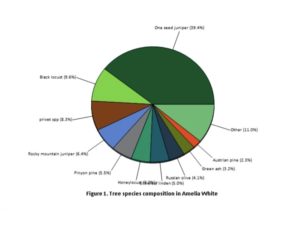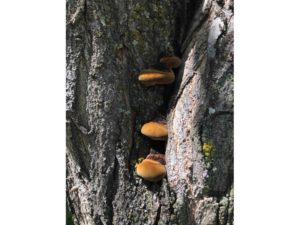Project Highlight: The Santa Fe Public Open Spaces Tree Inventory
By: Athena Beshur, Cynthia Feiden-Warsh, and Claire DishmanTree inventories are happening all over the world. A community-driven approach championed by the City of Santa Fe, Master Gardeners, and public volunteers, the Santa Fe Open Spaces Tree Inventory project is helping to build our urban forest by determining what trees thrive here under what conditions and making recommendations for future plantings. Working with trained arborists, we are learning to identify trees and the pests that afflict them and to ascertain why certain trees are doing poorly while others are succeeding. We gather and share this information, which will impact city planting decisions. Thus the project offers compounding benefits to our community.For this third year of the project, we focused on enhanced educational opportunities for participants, with spring workshops and building leadership within the project. We inventoried 218 trees in Amelia White park and 182 trees in Frenchy’s Field. We also captured the GPS coordinates for The Plaza, City Hall, and Cathedral Park, sites that were inventoried in 2016, before location data was collected.Overall, 542 trees will be added into the database, which is becoming increasingly useful for the City Parks Division, the Municipal Tree Board, and residents of Santa Fe. Co-leader Becky Touchett now holds a seat on the Municipal Tree Board. She is interfacing with the GIS department to make these data more useful to researchers and citizens, and she continues to be a strong advocate for broader application of the data. Amelia White Park, on Old Santa Fe Trail, was a significant part of our work this year. Deeded to the City of Santa Fe on June 19, 1966, this 3.6 acre park stands as the Korean Conflict Memorial. In 1995 the National Park Service granted it Santa Fe National Historic Trail certification status.The second-most populous tree at the park is Robinia pseudoacacia(black locust). On some of these we discovered a perennial bracket fungus exclusive to the species. Commonly known as the “cracked cap polypore,”Phellinus robiniaeis woody or bark-like on the top and velvety brown on its lower ring. Phellinusrefers to the cork-like substance of the mushroom, which is very hard.
Amelia White Park, on Old Santa Fe Trail, was a significant part of our work this year. Deeded to the City of Santa Fe on June 19, 1966, this 3.6 acre park stands as the Korean Conflict Memorial. In 1995 the National Park Service granted it Santa Fe National Historic Trail certification status.The second-most populous tree at the park is Robinia pseudoacacia(black locust). On some of these we discovered a perennial bracket fungus exclusive to the species. Commonly known as the “cracked cap polypore,”Phellinus robiniaeis woody or bark-like on the top and velvety brown on its lower ring. Phellinusrefers to the cork-like substance of the mushroom, which is very hard. In addition to identifying tree species and finding interesting (and sometimes destructive) pests and pathogens, we also measure tree size and assess condition. These values are brought into the iTree Eco software, which helps to illustrate population distribution as well as to quantify ecological services the trees provide.We encourage all Master Gardeners to volunteer a least once for this fun project. In addition to learning about trees, you’ll find out about our wonderful parks. We also welcome other organizations, fellow arborists, and individuals to participate. If you’re not affiliated with SFMGA and are interested, please contact Cynthia Feiden-Warsh (cfeidenwarsh@gmail.com)to find out how to become involved.
In addition to identifying tree species and finding interesting (and sometimes destructive) pests and pathogens, we also measure tree size and assess condition. These values are brought into the iTree Eco software, which helps to illustrate population distribution as well as to quantify ecological services the trees provide.We encourage all Master Gardeners to volunteer a least once for this fun project. In addition to learning about trees, you’ll find out about our wonderful parks. We also welcome other organizations, fellow arborists, and individuals to participate. If you’re not affiliated with SFMGA and are interested, please contact Cynthia Feiden-Warsh (cfeidenwarsh@gmail.com)to find out how to become involved.
